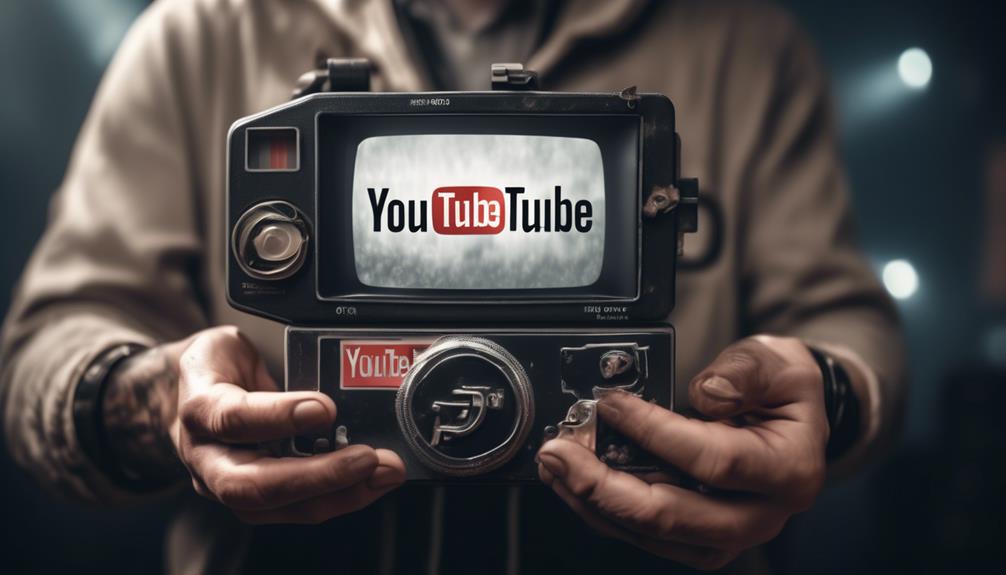
Is it easier to make money on Rumble or YouTube?
Did you know that YouTube has over 2 billion logged-in users each month?
As an aspiring content creator, you’re probably wondering where the grass is greener: YouTube, the video-sharing giant, or Rumble, a platform that’s been gaining traction recently.
There’s no denying that both platforms offer unique opportunities for monetization, but the question is, which one will provide a better return for your time and effort?
This isn’t a simple yes or no discussion, and as you navigate through the nuances of each platform, you’ll find the answer isn’t as straightforward as you might initially think. So, are you ready to explore this further?
Key Takeaways
- YouTube offers a well-established revenue model through its Partner Program, while Rumble has a profit-sharing model and video licensing options.
- Maximizing earnings on both platforms requires strategic monetization and innovation.
- User engagement plays a crucial role in earning potential, with YouTube having a larger user base and diverse engagement metrics.
- Content policies differ between Rumble and YouTube, impacting monetization potential based on ad revenue, view counts, and potentially on a per-view basis on Rumble.
Understanding Video Monetization

To truly grasp the potential of making money on Rumble and YouTube, you’ve got to understand the ins and outs of video monetization. At its core, video monetization is the process of earning revenue from your uploaded content, through avenues such as ad revenue, channel subscriptions, or direct viewer donations.
On YouTube, monetization is primarily through ads. You’ll earn money when viewers interact with ads on your videos or view them in full. You’ve also got the option of channel memberships, where viewers pay a monthly fee for exclusive benefits.
Rumble, on the other hand, brings a different approach. It operates on a licensing model. Your videos are distributed across Rumble’s network of partners, and you earn revenue based on views from these networks. You’ve also got the opportunity to earn from ads, but the licensing model is what sets Rumble apart.
Understanding these platforms is key to maximizing your earnings. It’s not just about creating engaging content, it’s about strategic monetization. So, analyze your options, leverage the unique aspects of each platform, and innovate to make money from your videos.
Exploring YouTube’s Revenue Model
To understand how to make money on YouTube, you must first grasp their revenue model. This involves examining YouTube’s monetization policies. Understanding how advertising revenue works is another key aspect. Additionally, learning about the requirements of the Partner Program is essential. Each of these elements plays a crucial role in determining your potential earnings on the platform.
YouTube’s Monetization Policies
Delving into YouTube’s revenue model, you’ll find a vast landscape of monetization policies that serve as the backbone for content creators’ earnings on the platform. These policies dictate the types of content that can be monetized, the monetization tools available, and the criteria for eligibility.
Among these policies, the YouTube Partner Program is most crucial. It allows you to earn from ads, channel memberships, and YouTube Premium revenue. Here’s a brief overview:
| Monetization Tool | Eligibility Criteria |
|---|---|
| Ads | 1,000 subscribers, 4,000 watch hours in the past 12 months |
| Channel memberships | 30,000 subscribers |
| YouTube Premium | Live in a country/region where YouTube Premium is available |
Understanding these policies can be your stepping stone towards making money on YouTube.
Understanding Advertising Revenue
Grasping the concept of advertising revenue is crucial in fully understanding YouTube’s revenue model. To break it down:
- Ad Impressions: This is when an ad is displayed. YouTube typically pays for every thousand impressions, also known as CPM (Cost Per Mille).
- Ad Engagement: If a viewer interacts with an ad, like clicking on it, the revenue is higher. This is because advertisers are willing to pay more for potential customers.
- Viewer’s Demographics: Ads targeted to certain demographics, such as age or location, can bring in more revenue.
Partner Program Requirements
In order to maximize your earnings on YouTube, it’s important you’re aware of their Partner Program requirements, which set the stage for gaining advertising revenue. You need at least 1,000 subscribers and 4,000 watch hours in the past year. Furthermore, you must reside in a country where the Partner Program is available, comply with all of YouTube’s policies and guidelines, and have an AdSense account linked to your YouTube account.
Understanding these prerequisites allows you to strategically grow your audience and increase your video views. The innovative approach is to create engaging content that draws followers, turning views into revenues. Being knowledgeable about the Partner Program requirements can help you make the most of YouTube’s advertising model and optimize your income potential.
Diving Into Rumble’s Monetization Plan
To fully understand how to make money on Rumble, it’s crucial to break down their monetization plan.
Rumble’s monetization strategy is relatively straightforward yet innovative, providing you with multiple avenues to generate income.
Here’s a three-point breakdown:
- Profit Sharing: Rumble operates on a profit-sharing model. They split ad revenue with you, the creator. Video views translate directly into earnings. The more your content is viewed, the more you earn.
- Video Licensing: Rumble also offers a chance to earn through video licensing. If your content is unique and compelling, Rumble might license it to other platforms. You’ll get a percentage of the licensing fee.
- Video Challenges: Rumble hosts video challenges where creators compete for cash prizes. This not only incentivizes quality content creation but also fosters a sense of community among creators.
In essence, Rumble’s monetization plan is comprehensive, providing you with diverse income streams. However, remember that your earning potential is closely tied to the quality and appeal of your content. So, your focus should be on creating content that resonates with your audience and stands out in the digital crowd.
Comparing User Engagement

Let’s now turn our attention to the critical topic of user engagement on Rumble and YouTube.
You’ll find it interesting to compare Rumble’s viewer interaction against YouTube’s user participation.
In doing so, we’ll use engagement metrics as a yardstick for this head-to-head comparison, providing insightful analysis on their relative strengths and weaknesses.
Rumble’s Viewer Interaction
Diving into Rumble’s viewer interaction, you’ll notice a distinct difference in user engagement compared to YouTube.
- Community: Rumble has a tight-knit community feel, fostering meaningful interactions. You’ll see more thoughtful comments and less spam.
- Content Discovery: Rumble’s algorithm prioritizes new content over popular content, making it easier for your videos to be seen and interacted with.
- Monetization: Unlike Youtube, Rumble’s viewer interaction directly impacts your earnings. The more views and engagement, the higher your revenue.
In essence, while Rumble’s user base is smaller, the quality of viewer interaction can be much higher. For creators seeking an innovative platform that values authentic engagement and provides a fair shot at visibility, Rumble might just be the ticket.
Youtube’s User Participation
Shifting our focus to YouTube, it’s crucial to understand how user participation and engagement function on this larger, more established platform. YouTube has a more diverse and extensive user base when compared to Rumble, leading to a more dynamic interaction landscape.
Consider the following table to understand YouTube’s user engagement better:
| Aspect | Frequency | Impact |
|---|---|---|
| Comments | High | Positive/Negative |
| Likes/Dislikes | High | Positive/Negative |
| Shares | Medium | Positive |
| Watch time | High | Positive |
| Subscriber Growth | Variable | Positive |
Comments and likes/dislikes reflect immediate reactions, while shares indicate a deeper level of engagement. Watch time contributes to your algorithmic popularity, and subscriber growth showcases your channel’s sustainability. Hence, to maximize earnings on YouTube, it’s essential to strategically manage these aspects, innovatively engaging with your audience.
Engagement Metrics Comparison
When comparing the engagement metrics of Rumble and YouTube, it’s essential to consider several key factors.
- Comment Frequency: YouTube typically has a higher comment frequency due to its larger user base. However, Rumble’s smaller, niche-focused community can yield more meaningful interactions.
- Like/Dislike Ratio & Share Rates: Rumble’s simple thumbs-up voting system may lead to a more positive like/dislike ratio. Yet, YouTube’s share rate tends to be higher due to its social media integrations.
- Watch Time & Subscriber Growth: YouTube’s advanced algorithms excel in boosting watch time and subscriber growth. Conversely, Rumble’s less crowded space may offer less competition.
Deciding between Rumble and YouTube depends on your strategic goals and audience engagement priorities.
Analyzing Content Policies

To understand how Rumble competes with YouTube, it’s crucial to scrutinize their respective content policies. Rumble tends to be more lenient, allowing a broader range of content and offering creators more freedom. However, this lack of strict control can sometimes result in low-quality content.
On the other hand, YouTube has a more stringent content policy. They’re well-known for their strict guidelines on issues like copyright infringement, hate speech, and violent or harmful content. While this may seem restrictive, it also ensures a higher level of content quality and safety for viewers.
The choice between Rumble and YouTube, then, isn’t just about potential earnings. It’s also about what type of content you’re creating and how you want it to be regulated. If you’re seeking a more open platform, Rumble may be the better choice. If you’re looking for a platform that emphasizes quality and viewer protection, YouTube may be more suitable.
In the end, both platforms have their advantages and it’s up to you to decide which one aligns more with your content strategy. Remember, successful content creation isn’t solely about making money, but also about meeting your audience’s expectations and adhering to certain standards.
Making the Final Decision
Ultimately, it’s your call whether to choose Rumble or YouTube, and this decision should be based on a thorough analysis of your content style, audience preferences, monetization potential, and comfort with content policies. It’s crucial to remember that both platforms offer unique growth opportunities, but they also have distinct operational mechanics and revenue models.
Consider the following points:
- Content style and audience: Rumble tends to favor more conservative, independent creators, while YouTube caters to a broader range of interests. Align your platform choice with your content style and target audience.
- Monetization potential: YouTube’s ad revenue model is mature and consistently profitable if you can hit high view counts, whereas Rumble’s revenue-sharing model is still developing, but it offers more income potential on a per-view basis.
- Comfort with content policies: YouTube’s guidelines are stricter and more comprehensive, which may affect your content creation. Rumble, on the other hand, promises less censorship.
In the end, your decision may hinge on balancing these factors with your objectives and comfort level. Understand that there’s no one-size-fits-all answer, but an informed choice will lead you towards the path of innovation and success.

